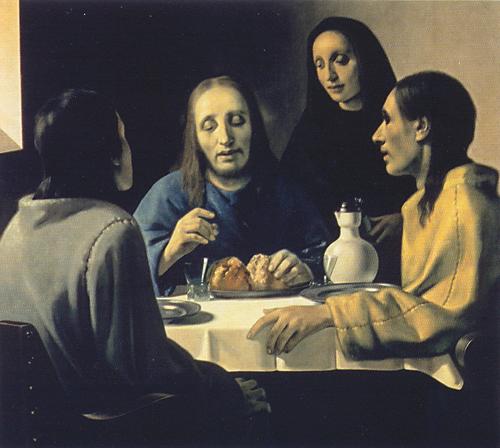Dolnick's The Forger's Spell

If this painting strikes you as being similar to a Vermeer, you're right. If this strikes as BEING a Vermeer, you're emphatically wrong. Above is the most famous painting by the most notorious forger of the 20th century, one Han Van Meegeren, morphine addict, womanizer, oh, and artist for Nazi Herman Goebbels.
The most fascinating aspect of this tale is that Van Meegeren's paintings were not even good. In fact, they were horrible (and made out of plastic). Van Meegeren's genius lay in his ability to play the best odds, and he really knew his audience.
Before Van Meegeren cast his net, The Dutch of the 1930s had fallen in love with Vermeer becuase of the calm, serene qualities of his paintings. The paintings that were popular then, and popular now, were his 'domestic' pictures: The Milkmaid, The Girl With a Pearl Earring. These paintings, however, were not as popular during Vermeer's lifetime, as people during the 17th century favored paintings of a more grander contemplation. Paintings of high quality back then depicted mythological or biblical themes, but Vermeer painted these, too, they're just not as popular, or as well known. Vermeer's early paintings are similar to Caravaggio's, an Italian painter known for his gritty scenes and chiarascuro. Vermeer's brilliant use of light probably stems from his early studies of Caravaggio's paintings.
By the time Van Meegeren came along, art critics were wondering about the connection between Vermeer's early biblical paintings and his later work. Van Meegeren, sly dog, provided the link. Notice in the above picture that the light comes from the left, as in many of Vermeer's later work. Yellow and blue are central to the color scheme, as they are in later Vermeer paintings. The pointilism on the bread (though really sloppy here) recalls the same element on the bread in The Milkmaid (a much more convincing example). However, the scene depicts Christ and his apostles, which provides the critical link to the earlier paintings. Oh, and it's a similar scene to one that Caravaggio painted.
Christ at Emmaeus fails in many ways, too, but Van Meegeren's victims would not discern these until later. The characters look like corpses with large eyes (considered popular in the 1930s), and the fabric of the clothes and tablecloth hang with the flexibility of wood. The figure in the front, in the yellow, has an inhumanly long arm hanging from a stovepipe sleeve. This, though, is the best picture of the six that Van Meegeren delivered to his gullible crowd. By the time the last painting was 'discoved,' it looked like perhaps Vermeer had painted the thing with his feet - while unconscious in a drunken stupor. Still, Van Meegeren would have gotten away with it, if Joop Pillar, an Amsterdam policeman, hadn't come come knocking at Van Meegeren's mansion door...
The best of Edward Dolnick's story is yet to come, and reading The Forger's Spell is a must for anyone who ever wondered about the forgery of fine art.

Comments
Post a Comment